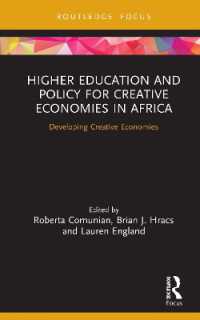Full Description
The zero coding of referents or other clausal constituents is one of the most natural, communicatively and cognitively-transparent grammatical devices in human language. Together with its functional equivalent, obligatory pronominal agreement, zero is both extremely widespread cross-linguistically and highly frequent in natural text. In the domain of reference, zero represents, somewhat paradoxically, either anaphorically-governed high continuity or cataphorically-governed low topicality. And whether in conjoined/chained or syntactically-subordinate clauses, zero is extremely well-governed, at a level approaching 100% in natural text. The naturalness, cross-language ubiquity and well-governedness of zero have been largely obscured by an approach that, for 30-odd years, has considered it a typological exotica, the so-called "pro-drop" associated with a dubious "non-configurational" language type. The main aim of this book is to reaffirm the naturalness, universality and well-governedness of zero by studying it from four closely related perspectives: (i) cognitive and communicative function; (ii) natural-text distribution; (iii) cross-language typological distribution; and (iv) the diachronic rise of referent coding devices. The latter is particularly central to our understanding the functional interplay between zero anaphora, pronominal agreement and related referent-coding devices.
Contents
1. Preface; 2. Natural zero; 3. Chapter 1: The communicative ecology of zero anaphora; 4. Chapter 2: The grammar of referential coherence as mental processing instructions; 5. Chapter 3: Zero and the rise of pronominal agreement; 6. Chapter 4: Early diachrony of pronominal agreement: A case study in Ute; 7. Chapter 5: Is zero anaphora a typological exotica?; 8. Chapter 6: Verbal zero anaphora: Verbless clauses; 9. Chapter 7: Cataphoric zero: Passive and antipassive voice; 10. Structural zero; 11. Chapter 8: Co-reference in relative clauses; 12. Chapter 9: Co-reference in verb complements; 13. Chapter 10: Co-reference in adverbial clauses; 14. Chapter 11: Zero, pronouns and clause-chaining; 15. Chapter 12: Promiscuous ill-governed zeros?; 16. Chapter 13: Zero and the puzzle of stranded adpositions; 17. Bibliography; 18. Index; 18. General index; 19. Language index








